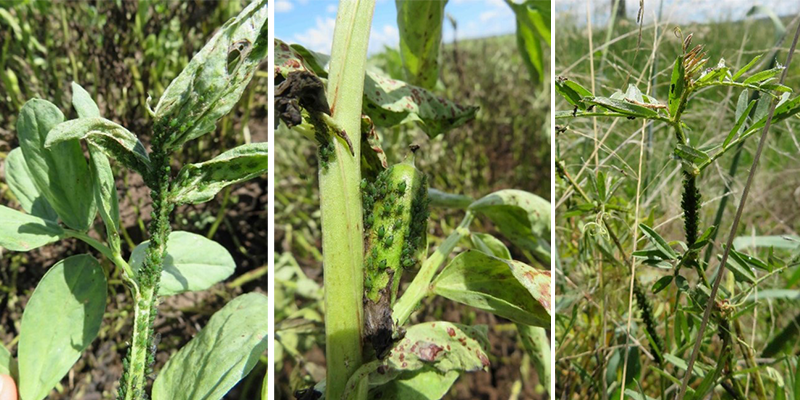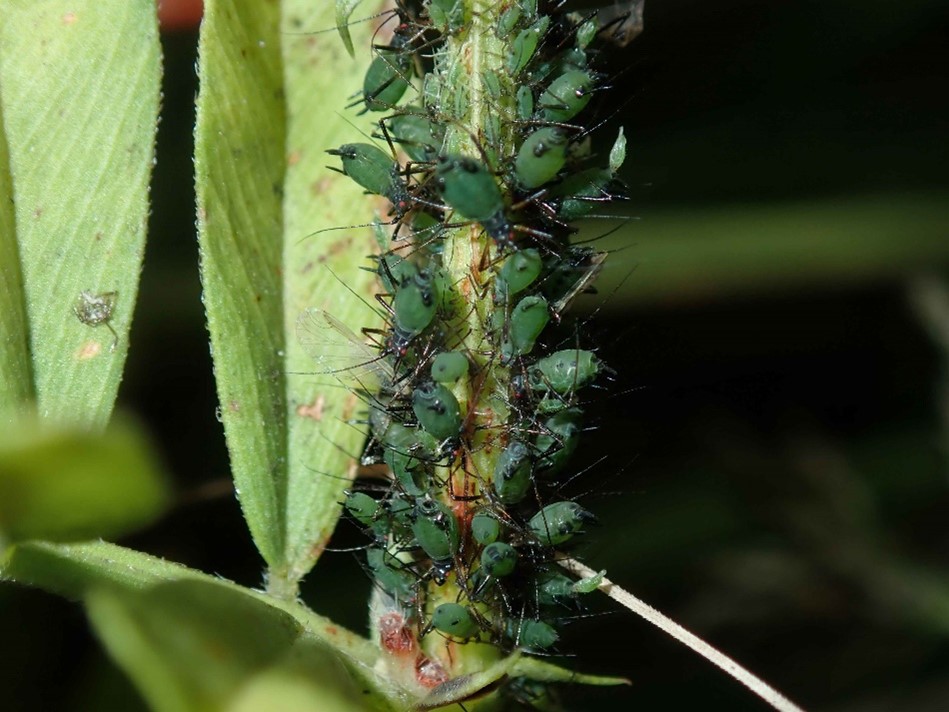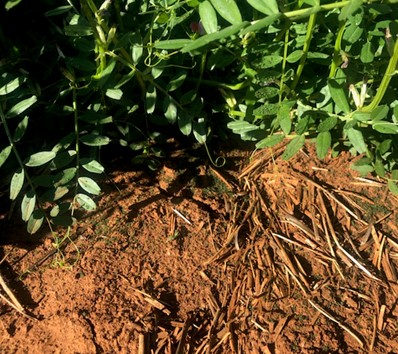After an initial report in Sydney, faba bean aphid (FBA – Megoura crassicauda) was confirmed in September 2017 in faba beans in Tamworth and Breeza. Very few commercial faba bean crops were sown during the drought in 2018 and 2019, however seasonal conditions then improved and FBA was found in July 2020 in faba bean trials in Grafton. This infestation was controlled using Aphidex (500 g pirimicarb/kg), as was a second infestation in early August.
Later in 2020, FBA was found in north-western NSW in a commercial faba bean crop and on woolly pod vetch (Vicia villosa) (Figure 1). Aphid presence was also confirmed from field observations and samples collected from private gardens in several more locations, including in the south-eastern NSW and Sydney regions (Figure 2).
Clearly, FBA managed to survive two drought seasons in mild, coastal environments, most likely by using annual legume weeds, such as woolly pod vetch, as host plants.

Figure 1. FBA dense colonies on stems and pods of faba beans and on woolly pod vetch (photo by Z. Duric)

Figure 2. FBA on vetch in Western Sydney (photo by T. Mesaglio)
Unfortunately, FBA was back this spring. Observations in NSW Department of Primary Industries experimental plots at Tamworth and Breeza in September 2021 confirmed increasing colonies of the aphid in faba beans. Both these infestations and another a couple of weeks later in a plot of vetches (V. sativa) in Tamworth were successfully controlled with aphicide (Figure 3). FBA was also recently found for the first time in Queensland on broad beans in an Ipswich backyard.

Figure 3. Dead FBA after Aphidex treatment (photo by S. Marshman)
There is not much overseas data on the impact of FBA, except that it is often named as a severe pest on a variety of fabaceous plants (Zhang et al., 2013). Our experience so far shows that FBA has a preference for faba beans and vetches, followed by common pea and lentils. Lucerne and subclover support limited reproduction and survival of FBA, and can persist as alternative hosts all year round, as can annual legume weeds.
So far, FBA has not been detected in any early established faba bean crops in northern NSW. Cold weather and heavy rainfall during winter may have suppressed their numbers. The aphid’s outbreaks tend to increase from late winter to springtime, which corelates with oversea results of the aphid being a dominant species on narrow leaf vetch (Vicia sativa subsp. nigra) in the spring (Kasai, 2016). Since spring’s favourable conditions allow aphids to migrate into crops, it is the best time to practice scouting and monitoring of the crop to manage aphid flights, before they establish in high numbers.
Always consider using the least disruptive management option. Before the season remove potential host plant sources from neighbouring paddocks and manage weeds in surrounding areas. The aphid tends to create large colonies on faba bean plants in just a few days, and the patchy colonisation makes observations, and later management, easier. At this point the registered rate of pirimicarb shows very good results in suppressing aphid numbers. Check the product label for specific registrations and spraying requirements. Most pirimicarb products are limited to two sprays per season at least 14 days apart.
Further information
Hales, D. F., Gillespie, P. S., Wade, S., & Dominiak, B. C. (2017). First detection of Megoura crassicauda Maudvilko (Hemiptera: Aphididae) in Australia and a review of its biology. General and Applied Entomology: The Journal of the Entomological Society of New South Wales, 45: 77-81.
Kasai A. (2016). Vetch aphid, Megoura crassicauda (Hemiptera: Aphididae), parasitism does not reduce the bean production of narrow-leaved vetch, Vicia sativa subsp. nigra (Fabaceae), Ecological Research 31: 189–194.
Zhang S.Z., Cao Z., Wang Q.L., Zhang F., Liu T.X. (2014). Exposing eggs to high temperatures affects the development, survival and reproduction of Harmonia axyridis. Journal of Thermal Biology. 39: 40–44.
